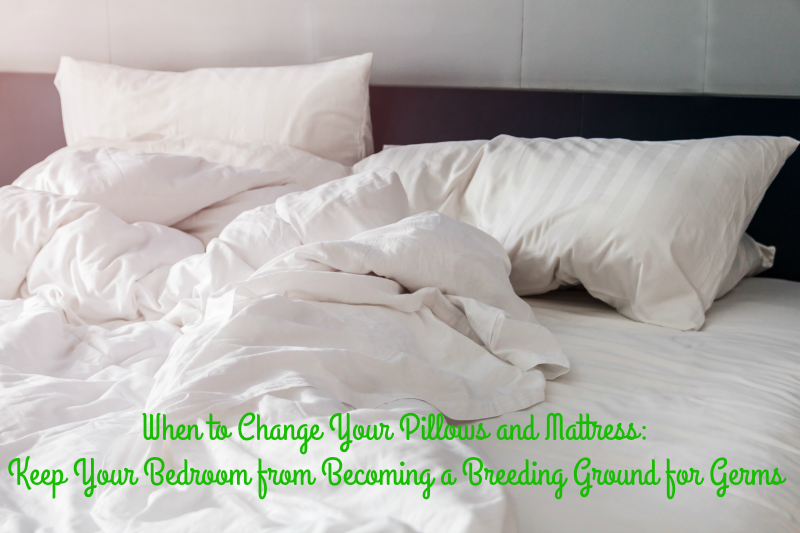With many products, it’s quite obvious when to replace them as you can see how much they’ve lost their functionality or have clear signs of wear and tear. But how would you know if it’s time to replace your pillows and mattresses? The signs of wear and tear of pillows and mattresses are often unclear. That’s because a mattress is always hidden beneath the bed cover which is why most of us aren’t aware of its deteriorating condition.
Even several years after having purchased a mattress, most of us think that our mattress is still ‘new’. But actually, it isn’t. Old mattresses provide accommodation for dust mites, allergens, germs, and bedbugs. This can happen to your mattress even if you wash the bed covers regularly. That’s why it’s crucial to know when exactly you should change your mattress as well as pillows.
When to Change Your Pillows
Getting attached to your pillow makes sense, but living with the same pillows can be harmful to your health even if you change your pillowcases regularly. Though sleep experts recommend getting a new pillow every few years, it entirely depends on how your pillow is treating you.
If you’re unsure whether your pillows are still giving you a good night’s sleep, then you should ask yourself the following questions:
- Is the batting or foam bumpy or lumpy?
- If you’re using a feather pillow, does it need to be fluffed up or pinched for support?
- Does your pillow stay static and unfolded when you fold it in half and then let go?
- Do your ankles, knees, or neck and back feel sore after waking up?
If your answer to any of these questions is “yes,” it’s time to get a new pillow!
When to Change Your Mattress
You spend approximately eight hours a day sleeping on a mattress. And if you have a comfortable mattress, it can sometimes be the only reason behind your energetic mood and alertness. However, to maintain your energy levels, it’s equally important to replace your mattress as soon as it loses its functionality. Below are the signs that help you identify if your mattress is old and needs a replacement:
- If you feel lethargic throughout the day but sleep better in a hotel room, your mattress is interfering with your sleep and health.
- If you’ve put on some weight but your mattress doesn’t treat those extra pounds well and you end up waking up dreary with stiff muscles, you need a new mattress.
- If you’re able to see a curve in the middle of your mattress while actually feeling the springs through your bed, it’s time to look for a new mattress. Find out more about this at Mattress-Guides.net/best-mattress-review/.
- If your mattress is pinging, creaking, or groaning all night, it’s a sign of wear and tear.
- If you can see dust mites and bed bugs in your mattress, a fresh, clean mattress deserves your attention.
- If your mattress is older than eight years, it has exceeded its expiry date.
Tips to Make Sure Your Bedroom Is Free From Germs
Nobody wants their bedroom to become a breeding ground for germs. So why should you? Keeping your bedroom free from germs doesn’t only let you maintain cleanliness, it also helps you maintain the usability of your mattress. Below are some useful tips to help you get a germs-free bedroom:
- To allow cross-ventilation, keep the windows open whenever possible.
- Change your mattress every 8 years so that your body can benefit from consistent comfort and support without interacting with harmful microbes.
- Of course, it’s impractical to wash a mattress. But you can use a mattress protector to ensure that your mattress isn’t absorbing harmful bacteria.
- Wash pillow cases, covers, and sheets with hot water as high temperatures kill dust mites and germs. Besides this, you can use any laundry additive to kill viruses and bacteria.
- Inspect if there are any broken slats or loose fittings that create a hurdle in how your mattress fits your bed. Check this every six months.
The Bottom Line
Besides the original quality, there are several factors that determine when you should actually replace your pillows and mattresses. Since your body changes over time, the need for enhanced support increases as well. That’s why it’s wise to examine the level of comfort provided by your pillows and mattress so that you can analyze if you need a replacement of one or both.
If you’ve taken proper care of your pillows and mattress, it’s possible to increase the longevity of these bedroom items while making sure to never let your bedroom become a breeding ground for germs.
Demi Faulkner is a Mom who works part-time as a cleaner. She’s a bit of a neat-freak and enjoys clearing up other people’s clutter, especially as she’s paid for it! She writes in her spare time, coming up with lifestyle article topics.
